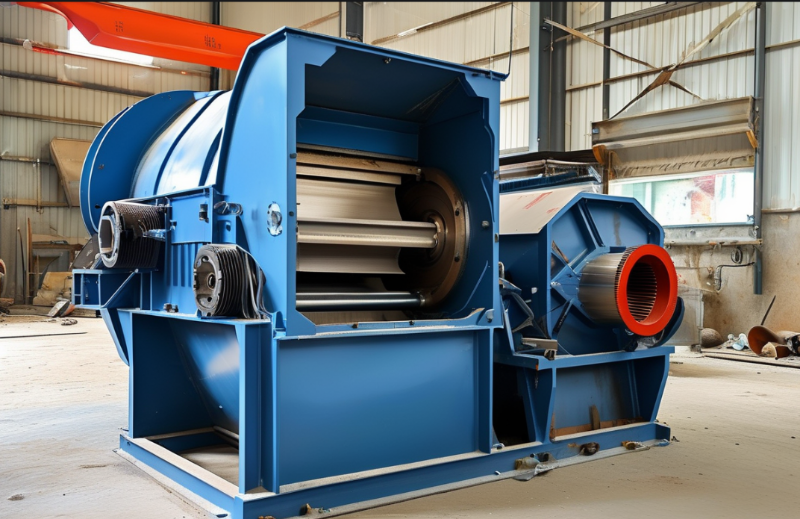In industrial plastic recycling and manufacturing, heavy-duty crushers serve as critical equipment for processing bulk materials efficiently. Understanding the cost structure and technological features of these systems helps businesses make informed investment
decisions.
Modern large-scale plastic crushers combine robust engineering with intelligent design:
1. Structural Components
Reinforced Frame: 10–15mm steel construction with anti-vibration mounts
Cutting Rotor: 800–1200mm diameter with dynamic balancing (G6.3 standard)
Blade System: 6–8 tungsten carbide blades (HRC 65+)
2. Performance Metrics
Throughput Capacity: 1–5 tons/hour
Power Consumption: 0.5–0.8 kWh/kg
Noise Levels: ≤80 dB(A) at operational distance
Particle Consistency: ±3% size variation
3. Advanced Features
Automatic load adjustment (±2% accuracy)
Hydraulic overload protection (response time <0.5s)
IoT-enabled performance monitoring
| Throughput Range | Motor Power | Base Price (USD) |
|---|---|---|
| 1–1.5 t/h | 75–110 kW | $85,000–$120,000 |
| 2–2.5 t/h | 132–160 kW | $130,000–$180,000 |
| 3–4 t/h | 200–250 kW | $190,000–$280,000 |
| 5+ t/h | 300+ kW | $300,000–$500,000 |
Hard Plastics (ABS/PC): Diamond-coated blades (+$12,000–$20,000)
Films & Bags: Anti-wrapping rotors (+$18,000–$25,000)
Composite Materials: Metal detection systems (+$8,000–$15,000)
Robotic feeding arms: +$25,000–$40,000
Explosion-proof design: +$30,000–$50,000
Remote diagnostics: +$15,000–$22,000
1. Energy Expenses
Average Consumption: 0.6 kWh/kg
Annual Cost (2-shift operation):
1.5 t/h system: $48,000–$72,000
3 t/h system: $95,000–$145,000
2. Maintenance Costs
| Component | Replacement Cycle | Cost Per Service | Annual Total |
|---|---|---|---|
| Blades | 800–1,200 hrs | $3,000–$10,000 | $20,000–$35,000 |
| Bearings | 3,000 hrs | $8,000–$15,000 | $12,000–$18,000 |
| Hydraulic Seals | 5,000 hrs | $5,000–$9,000 | $6,000–$10,000 |
3. Downtime Impact
Unplanned outages: $600–$2,500/hour
Advanced models reduce downtime by 50% via predictive analytics
| Region | 3 t/h System Base Price | Import Duties | Energy Rates | Total 5-Year Cost |
|---|---|---|---|---|
| North America | $220,000 | 0–5% | $0.10/kWh | $340,000–$380,000 |
| Europe | €200,000 | 10–15% | €0.18/kWh | €290,000–€330,000 |
| Southeast Asia | ¥1,500,000 | 20–30% | ¥0.08/kWh | ¥2,100,000–¥2,400,000 |
| South America | R$1,200,000 | 35–50% | R$0.15/kWh | R$1,800,000–R$2,200,000 |
1. Preventive Maintenance
Extend component lifespan by 30–40%
Reduce emergency repairs by 60%
2. Energy Recovery Systems
Regenerative braking saves 12–18% energy
Waste heat utilization cuts heating costs
3. Refurbished Equipment
40–50% cost savings over new machines
1-year warranty with service agreements
4. Government Incentives
Tax credits for energy-efficient models (up to 15%)
Recycling infrastructure grants
1. AI Optimization
Machine learning reduces material waste by 15–20%
Adaptive processing cuts energy use
2. Modular Design
Capacity expansion kits (+50% for $50,000–$80,000)
Retrofit automation packages (+$30,000–$60,000)
3. Sustainable Engineering
Recycled steel construction (cost premium: 8–12%)
Closed-loop cooling systems
1. Automotive Recycling
Metal separation systems: +$25,000–$40,000
Soundproof enclosures: +$15,000–$22,000
2. Electronics Waste
Anti-static technology: +$20,000–$35,000
Precision sorting: +$30,000–$45,000
3. Agricultural Plastics
Soil removal modules: +$25,000–$40,000
High-moisture tolerance: +$12,000–$18,000
Material Costs: Annual 5–7% increase for specialty steels
Regulatory Changes: Stricter emissions standards (+$20,000/system)
Automation: Robotics integration reducing labor costs by 35%
Requirement Assessment
Material types and contamination levels
Target throughput and facility space
Supplier Evaluation
10+ years of industry experience
Global service network coverage
Financial Planning
Lifecycle cost analysis (5–7 years)
Leasing vs. outright purchase
Performance Guarantees
Minimum efficiency standards
Spare parts availability
【本文标签】 废塑料英文文章
【责任编辑】